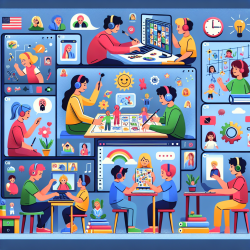As a speech-language pathologist deeply invested in data-driven decision-making, I am always on the lookout for innovative methods to enhance therapeutic outcomes. The study "Engaging teenagers productively in service design" offers a treasure trove of insights that can significantly improve how we engage teenagers in participatory design, particularly in health-related projects. This blog will discuss the key findings from the study and how practitioners can apply these insights to create more engaging and productive design sessions with teenagers.
Understanding the Challenges
Engaging teenagers in participatory design can be particularly challenging due to the unique developmental and social pressures they face. According to the UK National Children's Bureau, a significant percentage of young people feel stressed about schoolwork, physical appearance, and friendships. These stressors are compounded for teenagers with chronic health conditions like Type 1 Diabetes Mellitus, which requires rigorous self-care and management.
Key Strategies for Engagement
The study highlights several strategies that can make participatory design activities more engaging for teenagers:
- Use of Popular Culture: Incorporating elements of popular culture, such as TV shows and films, can make activities more relatable and engaging. For example, framing activities using references like 'Dragons' Den' or 'X-Factor' can help stage activities that are both productive and enjoyable.
- Language-Games: The concept of language-games, where familiar cultural references are used to explain design stages, was found to be highly effective. This approach ensures that the activities are not only engaging but also relevant to the design process.
- Creating Safe Spaces: It's crucial to create a safe environment where teenagers feel comfortable sharing their thoughts and ideas. Activities like 'bodymapping' and 'cool walls' allow teenagers to express their experiences and preferences in a non-threatening way.
Practical Applications
Here are some practical ways to implement these strategies in your practice:
- Integrate Popular Culture: Use familiar cultural references to frame your design activities. For example, you could use the format of a popular TV show to structure your sessions, making them more engaging and relatable for teenagers.
- Develop Language-Games: Create activities that mirror familiar games or scenarios. This will help teenagers understand the design process better and make their participation more meaningful.
- Focus on Fun and Engagement: Ensure that the activities are enjoyable and not overly complex. Short, interactive tasks with immediate outcomes can help maintain engagement.
Encouraging Further Research
While the study provides valuable insights, it also opens the door for further research. Practitioners are encouraged to explore other cultural references and language-games that could be effective in different contexts. Additionally, more research is needed to understand how these strategies can be adapted for teenagers with varying levels of motivation and engagement.
Conclusion
Engaging teenagers in participatory design requires a thoughtful approach that considers their unique challenges and interests. By integrating popular culture, developing language-games, and creating safe, engaging spaces, practitioners can significantly improve the effectiveness of their design sessions. To read the original research paper, please follow this link:
Engaging teenagers productively in service design.










